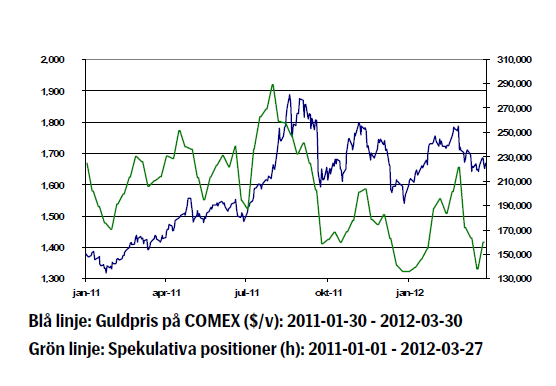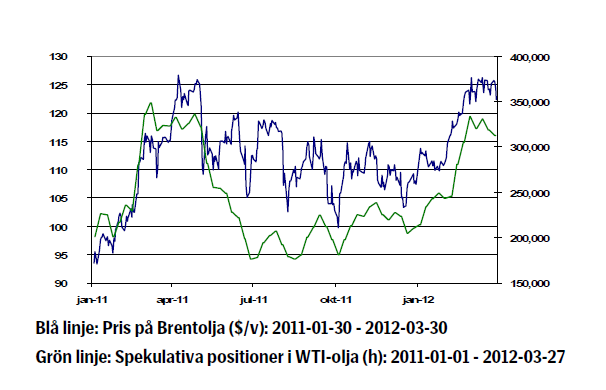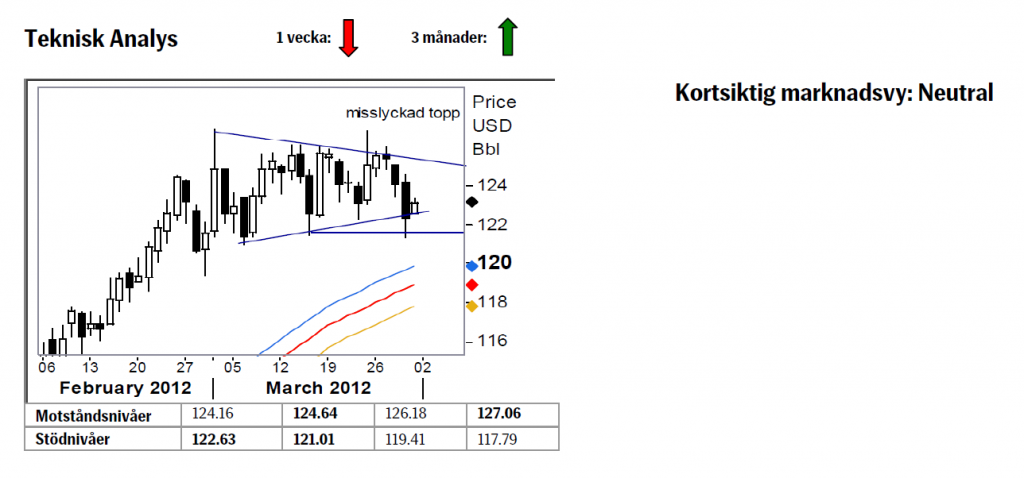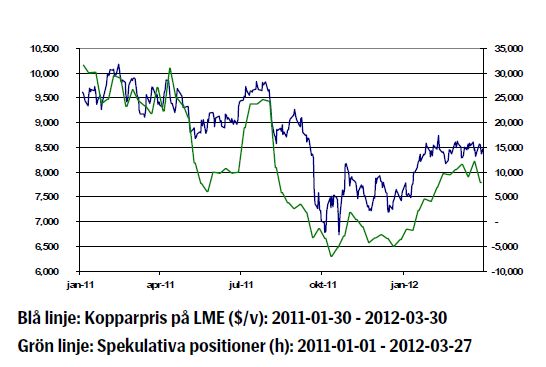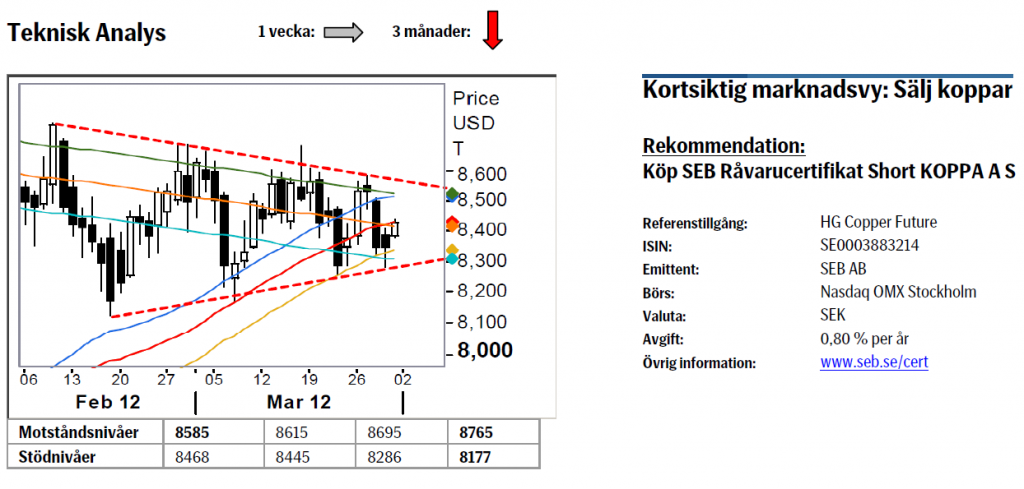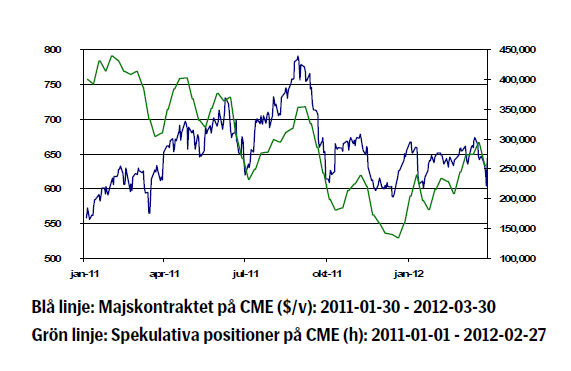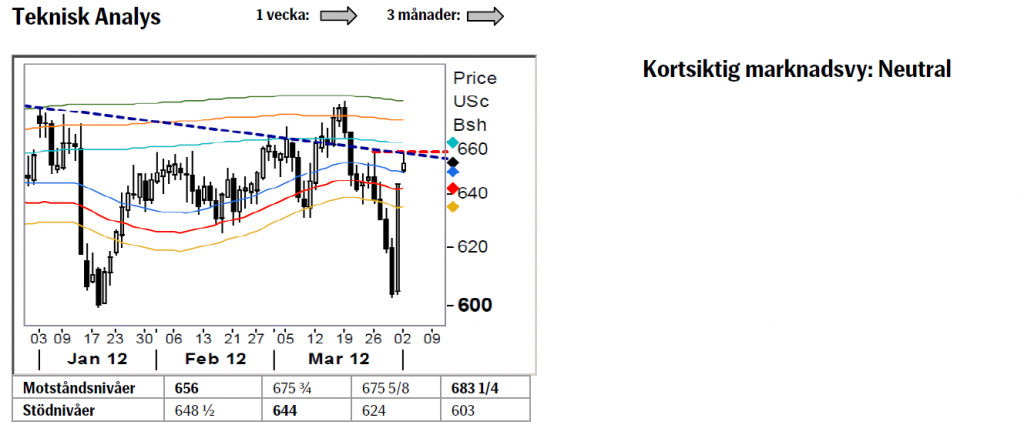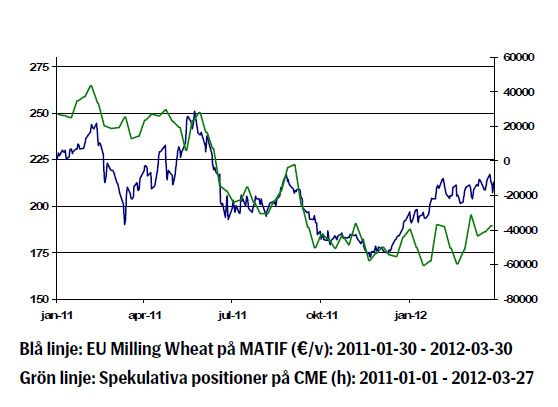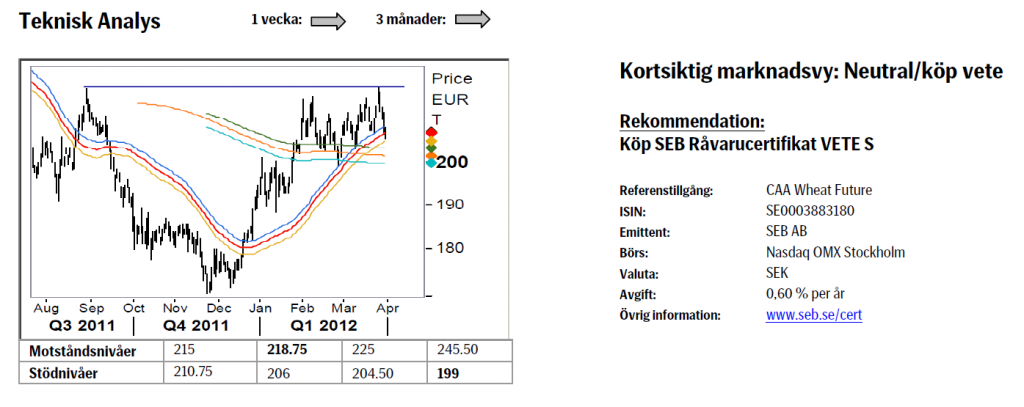Analys
SEB – Råvarukommentarer vecka 14 2012
Sammanfattning: Föregående vecka
- Energi: -2,68 %
UBS Bloomberg CMCI Energy TR Index
- Ädelmetaller: +0,47 %
UBS Bloomberg CMCI Precious Metals TR Index
- Industrimetaller: -0,37 %
UBS Bloomberg CMCI Industrial Metals TR Index
- Jordbruk: +0,40 %
UBS Bloomberg CMCI Agriculture TR Index
Kortsiktig marknadsvy:
- Guld: Neutral/köp
- Olja: Neutral
- Koppar: Sälj
- Majs: Neutral
- Vete: Neutral
Guld
- Ben Bernanke nämnde under början av veckan ett eventuellt fortsatt behov av stimulansåtgärder, detta bland annat för att stödja den amerikanska arbetsmarknaden. Guldet rusade upp mot 1700 USD på uttalandet, detta då marknaden tolkade budskapet som en möjlighet till en ytterligare våg av kvantitativa lättnader i USA.
- Den landsomfattande strejk bland Indiens 300 000 juvelerare som vi nämnde förra veckan visade sig göra ett visst avtryck i marknaden. Exempelvis lyckades denna aktion trycka ned priset igen under veckan, detta då landet är världens största köpare av fysiskt guld. Bakgrunden till strejken är en kraftigt ökad importskatt på guld. I fredags meddelade dock representanter för juvelerarna att man planerar att avbryta strejken, detta då den ökade skattesatsen verkar bli skjuten på framtiden.
- Efter en negativ utveckling de senaste veckorna börjar nu investerarna återigen gå in i guld. Den generella riskviljan får investerarna att gå ur trygga valutor (som den amerikanska dollarn) och in i exempelvis aktier och råvaror istället. Med denna utveckling ökar inflödet i guld och ger således stöd åt priset. Till skillnad från andra metaller får guld anses vara en rent finansiell eller smyckesrelaterad råvara.
- Enligt Bloomberg har försäljningen av både guld- och silvermynt i USA ökat igen, vilket visar på ett allmänt ökat intresse för guld som sparform.
- Teknisk Analys: Egentligen har inte speciellt mycket skett under innevarande vecka. Ett försök upp emot 1700 området blockerades och marknaden föll tillbaka ned mot den nedre delen av medelvärdesbanden. Vi fortsätter alltså vårt sökande efter mer bevis för en fortsättning av den långsiktiga uppåttrenden. Framgent gäller fortfarande att 1725/40 utgör bekräftelsepunkten för uppgång samt att vi däröver kan spika igen dörren till källaren.
Olja
- Både oljepriset och bolag inom oljesektorn gick under måndagen starkt på rapportering om att omvärldens sanktioner mot Iran kommer att minska landets råoljeexport med flera hundratusen fat per dag.
- Under större delen av förra veckan föll oljepriset, detta på politiska utspel om ökat utbud samt indikationer om en svag global tillväxt. Totalt sett föll priset tillbaka med nästan 1,8 procent.
- De politiska utspelen kommer från representanter för regeringarna ibland annat USA, Storbritannien och Frankrike, vilka uttryckt intresse för att släppa strategiska oljelager. Det spekuleras i dagsläget kring Obamas och Sarkozys möjligheter att bli omvalda med ett oljepris runt 125 USD per fat och att detta driver dem till att försöka få ner priset. Viktigt att känna till är att energiorganet IEA (International Energy Agency) är de som rekommenderar om sådana åtgärder och det förefaller för närvarande inte troligt att de kommer att göra det den närmaste tiden.
- På efterfrågesidan finns det i nuläget många frågetecken kring den egentliga hälsan för den globala ekonomin. I Kina, som till stor del agerat draglok de senaste åren, förekommer en kontrollerad men omfattande inbromsning. USA har de senaste månaderna visat sig vara ett starkt kort, men kvaliteten i återhämtningen på bland annat arbetsmarknaden kan ifrågasättas. I Europa är nu Spanien i fokus, vilket skapar oro avseende hela Eurozonen.
- Teknisk Analys: Sannolikheten för att vi kommer att göra rycket upp emot 129/131 området har fallit kraftigt efter förra fredagens falska brott upp ur triangeln. Dessutom har vi handlat under, temporärt men dock under 121.50, vilket ytterligare drar ned möjligheten till en snar uppgång. Detta faktum gör att vi för nästkommande vecka snarare har fokus på nedsidan än det omvända.
Koppar
- På måndagen steg kopparpriset rejält, detta bland annat på spekulationer om minskad metallproduktion som en effekt av de höga energipriserna.
- Under förra veckan kom sedan ovanligt svaga siffror avseende de aggregerade industrivinsterna för kinesiska bolag. Från att i drygt två års tid ha legat på en årlig positiv tillväxttakt över 20 procent justerades siffran ned så att vinsttillväxten nu istället är negativ. Man får i regel ta officiella siffror från Kina med en nypa salt, men likväl kan denna typ av data vara sådan att den trycker ned priset rejält på kort sikt.
- Enligt Bloomberg stiger för närvarande kopparlagren i både London och Shanghai. Den kinesiska inbromsningen verkar slå hårt mot efterfrågan på fysisk koppar och risken för en kraftig korrektion får anses vara överhängande.
- Sedan början av februari har de andra industrimetallerna gått ner med mellan 5–15 procent, detta samtidigt som kopparpriset på LME gått upp med nästan 2 procent.
- Enligt en undersökning från Bloomberg förväntar sig 11 av 25 tillfrågade analytiker att kopparpriset ska gå ned denna vecka. Samtidigt tror 7 analytiker på en uppgång och 7 är neutrala. Detta är den största andelen med en negativ marknadsutsikt sedan början av januari.
- Teknisk Analys: Testet av marsbotten renderade ett visst köpande varför vi nu studsat tillbaka in i mitten av innevarande intervall. Vi går därför in i nästa vecka med en neutral vy (även om råvarumarknaden rent generellt befinner sig på ett sluttande plan givet brottet i CRB index). Det kontrakterande intervallet måste snart komma till sitt slut och utbrottet, vilket håll det nu blir åt, har alla förutsättningar att bli explosivt!
Majs
- Majspriset föll med nästan åtta procent mellan veckans toppnotering på måndagen till dess bottennotering vid lunchtid på fredagen. Den generella uppfattningen var att de amerikanska bönderna skulle öka sin majssådd med nästan tre procent jämfört med 2011. Detta skulle i sådana fall innebära att majsarealen i USA skulle bli den största sedan andra världskriget.
- Den korrekta siffran, vilken kom ut i fredags eftermiddag, visade att marknaden till och med hade underskattat böndernas avsikter för årets skörd. Trots detta gick majkontraktet upp med över 6,5 procent och septemberkontraktet med drygt 3 procent.
- Det som fick majspriset att dra iväg var nedjusteringen av de redan låga lagernivåerna, vilket innebär att den befintliga utbudssituationen är fortsatt känslig, detta även om framtiden ser ljusare ut. Detta förklarar även skillnaden i uppgången mellan frontmånadskontraktet och septemberkontraktet.
- Vi anser att osäkerheten är stor denna vecka och ändrar vår kortsiktigt svagt positiva vy till helt neutral. Vinsthemtagningar skulle kunna tynga majspriset efter fredagens kraftigt positiva rörelse.
- Teknisk Analys: Fredagens statistik verkar ha överraskat marknaden å det grövsta givet den kraftfulla uppgång som den resulterade i. Intressant nog har uppgången än så länge stannat mot 656 motståndet. Tas detta ut lär resultatet bli ett nytt försök att bryta upp ur oktober-kanalen.
Vete
- Precis som för majsen gick vetepriset i både Europa och USA ned rejält inför det amerikanska jordbruksdepartementets (USDA) rapport på fredagen. Marknaden förväntade sig något större odlingsarealer för majs, vete och sojabönor. En typ av råvara som enligt förväntningarna skulle få stå tillbaks var bomull, vars pris under veckan gick upp med nästan fem procent inför rapporten.
- I Chicago steg vetepriset med drygt åtta procent under fredagseftermiddagen, detta efter att USDA rapporterat om en minskning med nästan 16 procent för de amerikanska vetelagren jämfört med förra året. Vidare kommer de amerikanska bönderna troligtvis plantera mindre vete än vad marknaden hade förväntat sig.
- I Paris steg priset på kvarnvete under fredagen med 3,75 procent. Den svaga amerikanska spannmålsstatistiken samt uttalanden från Ukraina om ett eventuellt bortfall med över 40 procent av landets vintervetesproduktion tryckte priset uppåt.
- Sedan årsskiftet har vetepriset i Chicago i princip rört sig sidledes, detta samtidigt som priset i Paris gått upp med drygt sex procent. Den relativa skillnaden kommer framförallt från de köldrelaterade problem som den innevarande skörden av vintervete haft i Europa.
- Även om mycket talar för vinsthemtagningar denna vecka tycker vi inte att man ska ta en kort position i MATIF-vete denna vecka, detta med bakgrund av den stora osäkerheten avseende den europeiska skörden.
- Teknisk Analys: I och med misslyckandet att hålla sig kvar över januari/ februari-topparna utlöstes en mindre våg av vinsthemtagningar. Vi hävdar dock att det underliggande mönstret fortfarande är positivt varför studsen upp från 55-dagarsbandet har en god chans att bli början på en ny uppgångsfas. Icke desto mindre finns det fortfarande, till dess att 219 bryts, ett visst utrymme på nedsidan, mot 55-233dagars banden och februari botten,
[box]SEB Veckobrev Veckans råvarukommentar är producerat av SEB Merchant Banking och publiceras i samarbete och med tillstånd på Råvarumarknaden.se[/box]
Disclaimer
The information in this document has been compiled by SEB Merchant Banking, a division within Skandinaviska Enskilda Banken AB (publ) (“SEB”).
Opinions contained in this report represent the bank’s present opinion only and are subject to change without notice. All information contained in this report has been compiled in good faith from sources believed to be reliable. However, no representation or warranty, expressed or implied, is made with respect to the completeness or accuracy of its contents and the information is not to be relied upon as authoritative. Anyone considering taking actions based upon the content of this document is urged to base his or her investment decisions upon such investigations as he or she deems necessary. This document is being provided as information only, and no specific actions are being solicited as a result of it; to the extent permitted by law, no liability whatsoever is accepted for any direct or consequential loss arising from use of this document or its contents.
About SEB
SEB is a public company incorporated in Stockholm, Sweden, with limited liability. It is a participant at major Nordic and other European Regulated Markets and Multilateral Trading Facilities (as well as some non-European equivalent markets) for trading in financial instruments, such as markets operated by NASDAQ OMX, NYSE Euronext, London Stock Exchange, Deutsche Börse, Swiss Exchanges, Turquoise and Chi-X. SEB is authorized and regulated by Finansinspektionen in Sweden; it is authorized and subject to limited regulation by the Financial Services Authority for the conduct of designated investment business in the UK, and is subject to the provisions of relevant regulators in all other jurisdictions where SEB conducts operations. SEB Merchant Banking. All rights reserved.
Analys
Brent crude ticks higher on tension, but market structure stays soft

Brent crude has climbed roughly USD 1.5-2 per barrel since Friday, yet falling USD 0.3 per barrel this mornig and currently trading near USD 67.25/bbl after yesterday’s climb. While the rally reflects short-term geopolitical tension, price action has been choppy, and crude remains locked in a broader range – caught between supply-side pressure and spot resilience.

Prices have been supported by renewed Ukrainian drone strikes targeting Russian infrastructure. Over the weekend, falling debris triggered a fire at the 20mtpa Kirishi refinery, following last week’s attack on the key Primorsk terminal.
Argus estimates that these attacks have halted ish 300 kbl/d of Russian refining capacity in August and September. While the market impact is limited for now, the action signals Kyiv’s growing willingness to disrupt oil flows – supporting a soft geopolitical floor under prices.
The political environment is shifting: the EU is reportedly considering sanctions on Indian and Chinese firms facilitating Russian crude flows, while the U.S. has so far held back – despite Bessent warning that any action from Washington depends on broader European participation. Senator Graham has also publicly criticized NATO members like Slovakia and Hungary for continuing Russian oil imports.
It’s worth noting that China and India remain the two largest buyers of Russian barrels since the invasion of Ukraine. While New Delhi has been hit with 50% secondary tariffs, Beijing has been spared so far.
Still, the broader supply/demand balance leans bearish. Futures markets reflect this: Brent’s prompt spread (gauge of near-term tightness) has narrowed to the current USD 0.42/bl, down from USD 0.96/bl two months ago, pointing to weakening backwardation.
This aligns with expectations for a record surplus in 2026, largely driven by the faster-than-anticipated return of OPEC+ barrels to market. OPEC+ is gathering in Vienna this week to begin revising member production capacity estimates – setting the stage for new output baselines from 2027. The group aims to agree on how to define “maximum sustainable capacity,” with a proposal expected by year-end.
While the IEA pegs OPEC+ capacity at 47.9 million barrels per day, actual output in August was only 42.4 million barrels per day. Disagreements over data and quota fairness (especially from Iraq and Nigeria) have already delayed this process. Angola even quit the group last year after being assigned a lower target than expected. It also remains unclear whether Russia and Iraq can regain earlier output levels due to infrastructure constraints.
Also, macro remains another key driver this week. A 25bp Fed rate cut is widely expected tomorrow (Wednesday), and commodities in general could benefit a potential cut.
Summing up: Brent crude continues to drift sideways, finding near-term support from geopolitics and refining strength. But with surplus building and market structure softening, the upside may remain capped.
Analys
Volatile but going nowhere. Brent crude circles USD 66 as market weighs surplus vs risk

Brent crude is essentially flat on the week, but after a volatile ride. Prices started Monday near USD 65.5/bl, climbed steadily to a mid-week high of USD 67.8/bl on Wednesday evening, before falling sharply – losing about USD 2/bl during Thursday’s session.

Brent is currently trading around USD 65.8/bl, right back where it began. The volatility reflects the market’s ongoing struggle to balance growing surplus risks against persistent geopolitical uncertainty and resilient refined product margins. Thursday’s slide snapped a three-day rally and came largely in response to a string of bearish signals, most notably from the IEA’s updated short-term outlook.
The IEA now projects record global oversupply in 2026, reinforcing concerns flagged earlier by the U.S. EIA, which already sees inventories building this quarter. The forecast comes just days after OPEC+ confirmed it will continue returning idle barrels to the market in October – albeit at a slower pace of +137,000 bl/d. While modest, the move underscores a steady push to reclaim market share and adds to supply-side pressure into year-end.
Thursday’s price drop also followed geopolitical incidences: Israeli airstrikes reportedly targeted Hamas leadership in Doha, while Russian drones crossed into Polish airspace – events that initially sent crude higher as traders covered short positions.
Yet, sentiment remains broadly cautious. Strong refining margins and low inventories at key pricing hubs like Europe continue to support the downside. Chinese stockpiling of discounted Russian barrels and tightness in refined product markets – especially diesel – are also lending support.
On the demand side, the IEA revised up its 2025 global demand growth forecast by 60,000 bl/d to 740,000 bl/d YoY, while leaving 2026 unchanged at 698,000 bl/d. Interestingly, the agency also signaled that its next long-term report could show global oil demand rising through 2050.
Meanwhile, OPEC offered a contrasting view in its latest Monthly Oil Market Report, maintaining expectations for a supply deficit both this year and next, even as its members raise output. The group kept its demand growth estimates for 2025 and 2026 unchanged at 1.29 million bl/d and 1.38 million bl/d, respectively.
We continue to watch whether the bearish supply outlook will outweigh geopolitical risk, and if Brent can continue to find support above USD 65/bl – a level increasingly seen as a soft floor for OPEC+ policy.
Analys
Waiting for the surplus while we worry about Israel and Qatar

Brent crude makes some gains as Israel’s attack on Hamas in Qatar rattles markets. Brent crude spiked to a high of USD 67.38/b yesterday as Israel made a strike on Hamas in Qatar. But it wasn’t able to hold on to that level and only closed up 0.6% in the end at USD 66.39/b. This morning it is starting on the up with a gain of 0.9% at USD 67/b. Still rattled by Israel’s attack on Hamas in Qatar yesterday. Brent is getting some help on the margin this morning with Asian equities higher and copper gaining half a percent. But the dark cloud of surplus ahead is nonetheless hanging over the market with Brent trading two dollar lower than last Tuesday.

Geopolitical risk premiums in oil rarely lasts long unless actual supply disruption kicks in. While Israel’s attack on Hamas in Qatar is shocking, the geopolitical risk lifting crude oil yesterday and this morning is unlikely to last very long as such geopolitical risk premiums usually do not last long unless real disruption kicks in.
US API data yesterday indicated a US crude and product stock build last week of 3.1 mb. The US API last evening released partial US oil inventory data indicating that US crude stocks rose 1.3 mb and middle distillates rose 1.5 mb while gasoline rose 0.3 mb. In total a bit more than 3 mb increase. US crude and product stocks usually rise around 1 mb per week this time of year. So US commercial crude and product stock rose 2 mb over the past week adjusted for the seasonal norm. Official and complete data are due today at 16:30.
A 2 mb/week seasonally adj. US stock build implies a 1 – 1.4 mb/d global surplus if it is persistent. Assume that if the global oil market is running a surplus then some 20% to 30% of that surplus ends up in US commercial inventories. A 2 mb seasonally adjusted inventory build equals 286 kb/d. Divide by 0.2 to 0.3 and we get an implied global surplus of 950 kb/d to 1430 kb/d. A 2 mb/week seasonally adjusted build in US oil inventories is close to noise unless it is a persistent pattern every week.
US IEA STEO oil report: Robust surplus ahead and Brent averaging USD 51/b in 2026. The US EIA yesterday released its monthly STEO oil report. It projected a large and persistent surplus ahead. It estimates a global surplus of 2.2 m/d from September to December this year. A 2.4 mb/d surplus in Q1-26 and an average surplus for 2026 of 1.6 mb/d resulting in an average Brent crude oil price of USD 51/b next year. And that includes an assumption where OPEC crude oil production only averages 27.8 mb/d in 2026 versus 27.0 mb/d in 2024 and 28.6 mb/d in August.
Brent will feel the bear-pressure once US/OECD stocks starts visible build. In the meanwhile the oil market sits waiting for this projected surplus to materialize in US and OECD inventories. Once they visibly starts to build on a consistent basis, then Brent crude will likely quickly lose altitude. And unless some unforeseen supply disruption kicks in, it is bound to happen.
US IEA STEO September report. In total not much different than it was in January
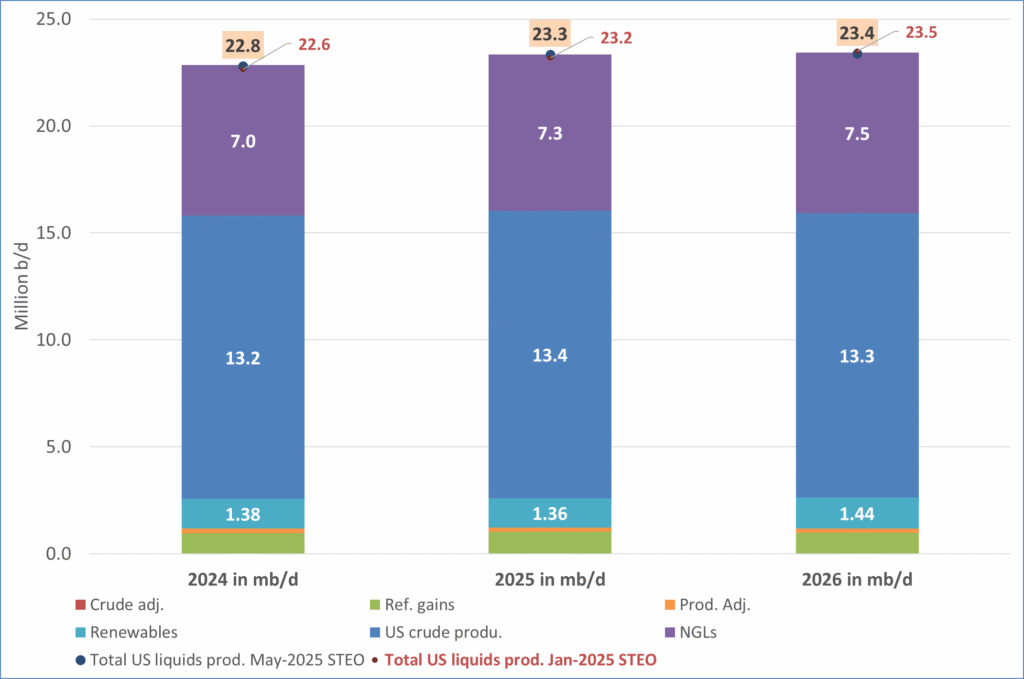
US IEA STEO September report. US crude oil production contracting in 2026, but NGLs still growing. Close to zero net liquids growth in total.
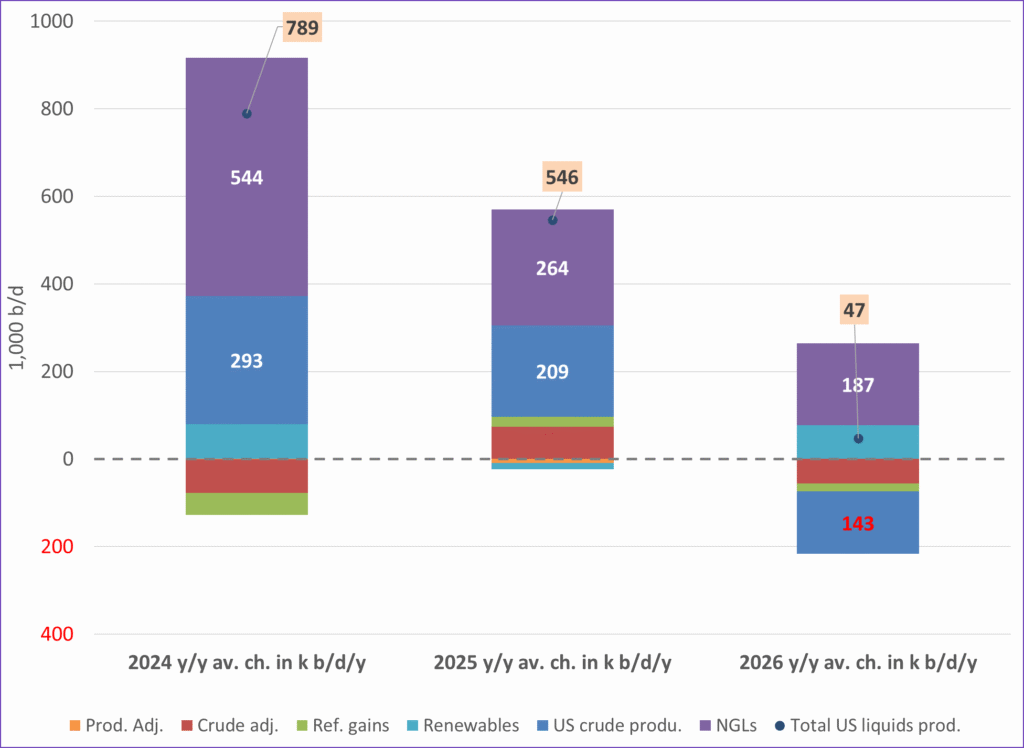
-

 Nyheter4 veckor sedan
Nyheter4 veckor sedanMeta bygger ett AI-datacenter på 5 GW och 2,25 GW gaskraftverk
-
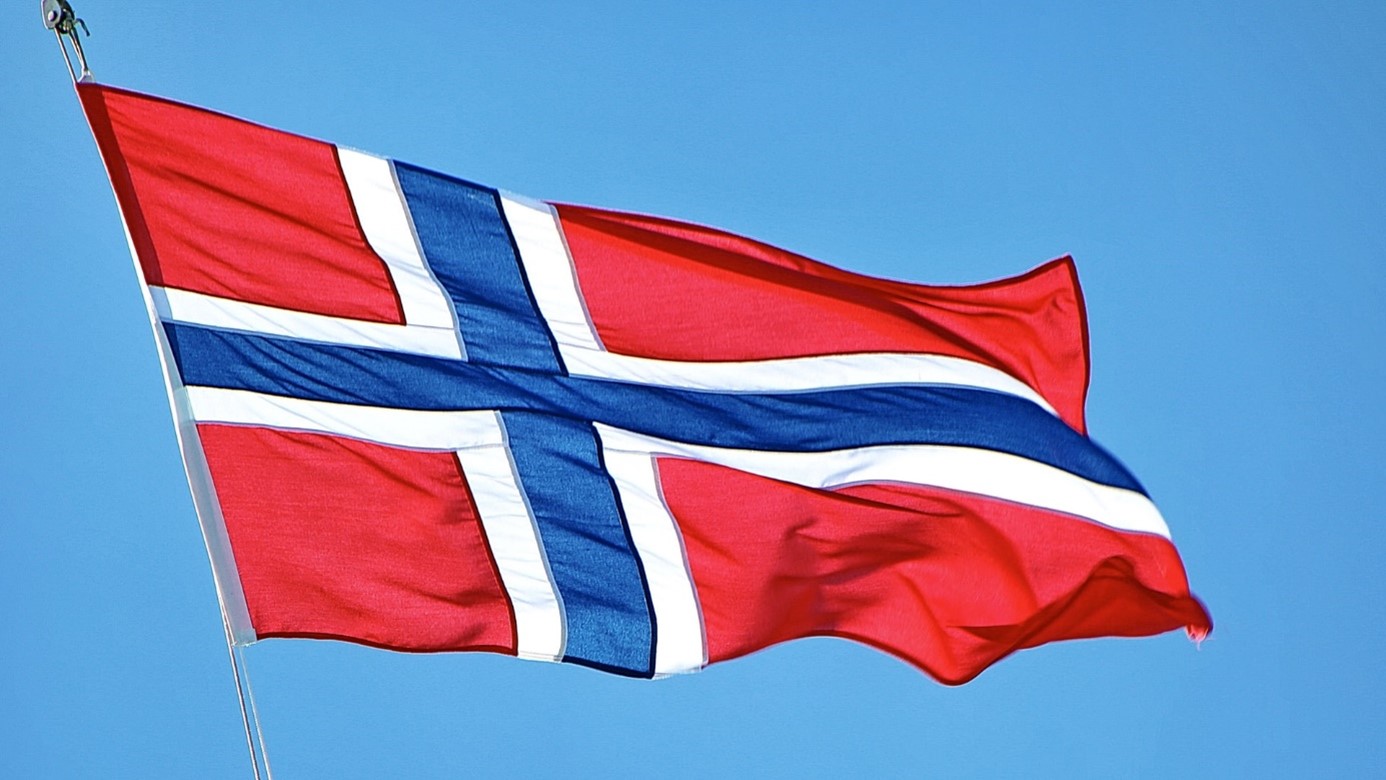
 Nyheter4 veckor sedan
Nyheter4 veckor sedanAker BP gör ett av Norges största oljefynd på ett decennium, stärker resurserna i Yggdrasilområdet
-

 Nyheter4 veckor sedan
Nyheter4 veckor sedanSommarens torka kan ge högre elpriser i höst
-

 Analys4 veckor sedan
Analys4 veckor sedanBrent edges higher as India–Russia oil trade draws U.S. ire and Powell takes the stage at Jackson Hole
-

 Nyheter3 veckor sedan
Nyheter3 veckor sedanMahvie Minerals är verksamt i guldrikt område i Finland
-

 Analys4 veckor sedan
Analys4 veckor sedanIncreasing risk that OPEC+ will unwind the last 1.65 mb/d of cuts when they meet on 7 September
-

 Nyheter3 veckor sedan
Nyheter3 veckor sedanNeil Atkinson spår att priset på olja kommer att stiga till 70 USD
-

 Analys2 veckor sedan
Analys2 veckor sedanOPEC+ in a process of retaking market share



